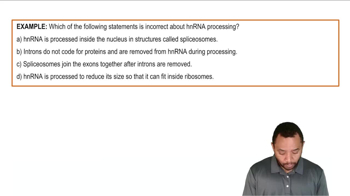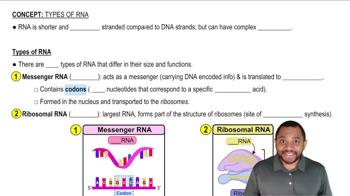Here are the essential concepts you must grasp in order to answer the question correctly.
Spliceosome
The spliceosome is a complex molecular machine found in the nucleus of eukaryotic cells. It is responsible for the splicing of pre-messenger RNA (hnRNA), which involves the removal of non-coding sequences (introns) and the joining of coding sequences (exons). This process is crucial for the maturation of hnRNA into functional mRNA, which can then be translated into proteins.
Recommended video:
Processing of Pre-mRNA Example 1
hnRNA (Heterogeneous Nuclear RNA)
Heterogeneous nuclear RNA (hnRNA) refers to the primary transcript of eukaryotic genes, which includes both exons and introns. hnRNA is initially synthesized from DNA and undergoes several processing steps, including capping, polyadenylation, and splicing, to become mature mRNA. Understanding hnRNA is essential for grasping how gene expression is regulated at the RNA level.
Recommended video:
RNA Splicing
RNA splicing is the process by which introns are removed from hnRNA and exons are joined together to form a continuous coding sequence. This process is facilitated by the spliceosome and is vital for generating mature mRNA that accurately reflects the coding information of the gene. Proper splicing is crucial for the correct expression of genes and the production of functional proteins.
Recommended video:
 Verified step by step guidance
Verified step by step guidance Verified video answer for a similar problem:
Verified video answer for a similar problem:



 2:25m
2:25m